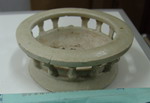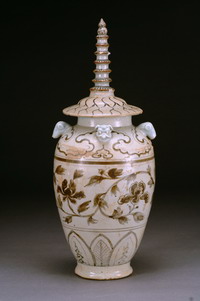

The invention of porcelain was a unique contribution of ancient Chinese people to human civilization. Since then, porcelain has been popular for its jade-like texture. The brilliant porcelain culture became symbolic of ancient China.
This exhibition is divided into two parts. Part I mainly focuses on the unearthed porcelain, and shows the development of monochrome-glazed porcelain in Hubei before the Yuan Dynasty. Part II mainly concentrates on the porcelain handed down from ancient times collected by the museum, and reveals the progress of porcelain in and after the Yuan Dynasty. Most of the relics are shown to the public for the first time.
In Hubei, the appearance of primitive porcelain could be traced back to the Shang and Zhou dynasties. From the Six Dynasties period till the Sui and Tang dynasties, celadon was predominant. Since the founding of the People’s Republic of China, archeologists in Hubei have excavated a large number of tombs dating from the Wei and Jin dynasties and the Six Dynasties period in Ezhou east of Liangzi Lake, and hundreds of Sui and Tang tombs in Wuchang, Wuhan. A great deal of celadon was unearthed from those tombs. In the Song Dynasty, greenish white porcelain was produced in Hubei. In the 1980s, archeologists in Hubei discovered and excavated the site of a Song kiln for producing such porcelain at Qingshan Village, Jiangxia District, Wuhan. That was followed by the discovery and excavation of many other kiln sites, which filled in a gap in porcelain archeology in Hubei. Chinese porcelain had monochrome glaze only until the Yuan Dynasty, when blue-and-white porcelain appeared. The vase with pagoda-shaped lid and blue-and-white peony design, unearthed from a tomb dating from 1319 (the sixth year of Yanyou) in Huangmei, Hubei, is the oldest of Yuan blue-and-white porcelain articles so far discovered, being dozens of years older than the typical Zheng-style ones. Two blue-and-white prunus vases were unearthed from the Ming tomb of Prince Yingjing at Zhongxiang, which was unearthed by the museum in recent years. They are typical of Yuan blue-and-white porcelain in shape, paste, decoration and glaze colors. In particular, the prunus vase with design of four lovers is almost identical with the blue-and-white one with the same design handed down from ancient times. In the 1950s, the Palace Museum in Beijing transferred to the museum a number of Qing porcelain articles that cover all types of official-kiln porcelain made during the period. The best of them were made in the Three Reigns.
1、Celadon figurine supporting a lamp

Three Kingdoms period
Unearthed at Yichang No.1 Middle School in 1970
Height: 33.5 cm, diameter of upper tray: 10.6 cm, diameter of middle tray: 12.7 cm, diameter of bottom tray: 20.4 cm
The article consists of four parts: at the bottom is a shallow tray serving as the base, on which stands a cylindrical figure having a flat face with eyebrows and a beard; on top of its head is the middle tray, on which stands a cylinder adorned with a diamond pattern composed of cord design; on top of the cylinder is a bowl-shaped lamp. The lamp is coated in bluish green glaze with cracks. Lively designed and smooth color, it is one of the best of all Three-Kingdoms-period celadon.
2、White-glaze openwork inkslab with ring foot

Tang Dynasty
Unearthed from the tomb of Li Hui in Yun County in 1985
Height: 5.2 cm, face diameter: 11.1 cm, bottom diameter: 12.8 cm
Li Hui was the grandson of Li Shimin, the first emperor in the Tang Dynasty, and the son of Li Tai. This inkslab is finely shaped and well preserved, with securely attached glaze. It is one of the best early white porcelain articles.
3.Vase with pagoda-shaped lid and blue-and-white peony design

Yuan Dynasty
Unearthed at the kiln factory at Xichi, Huangmei County in 1975
Originally kept at Museum of Huangmei
Height: 42.2, mouth diameter: 9.3 cm, bottom diameter: 10.3 cm
The vase with pagoda-shaped lid and blue-and-white peony design, unearthed from a tomb dating from 1319 (the sixth year of Yanyou) in Huangmei, Hubei, is about dozens of years older than the typical Zheng-style Yuan blue-and-white porcelain. It is similar to the typical Zheng-style Yuan blue-and-white porcelain in paste and decoration, differing from the Zhizheng-style in that the glaze is not made of suni boqing (smalt). As the oldest integral Yuan blue-and-white porcelain article, it occupies an important position in the history of such porcelain.
Blue-and-white prunus vase with design of four lovers
Yuan Dynasty
Unearthed from the tomb of Prince Yingjing in Zhongxiang in 2006
Height: 38.7, mouth diameter: 6.4 cm, bottom diameter: 13 cm
This vase is adorned with a peony-surrounded phoenix round the shoulder, and a picture of four lovers round the waist (Wang Xizhi the lover of orchid, Tao Yuanming the lover of chrysanthemum, Zhou Dunyi the lover of lotus, and Lin Hejing the lover of plum and crane), and lotus design round the base. The three layers of decorations are separated by curling-grass design and brocade-ribbon design. The bluish white glaze is shiny and brilliant. It is a rare masterwork of Yuan blue-and-white porcelain that was scientifically unearthed.
Blue-and-white cups with design of flowers in twelve months and the mark kangxi
Height: 4.9, mouth diameter: 6.6, bottom diameter: 2.7 cm
This set of twelve blue-and-white press-hand cups feature in-season flowers in twelve months—winter jasmine in January, apricot blossom in February, peach blossom in March, peony in April, pomegranate blossom in May, lotus in June, orchid in July, osmanthus flower in August, chrysanthemum in September, Chinese rose in October, plum blossom in November, and daffodil in December. Each flower is accompanied by an ode. There is a regular-script inscription saying ‘made in the reign of Kangxi of the Qing Dynasty’ on the bottom of each cup. Combining poetry, painting, calligraphy, seal cutting and porcelain art, this set is one of the best among the Qing official-kiln porcelain.